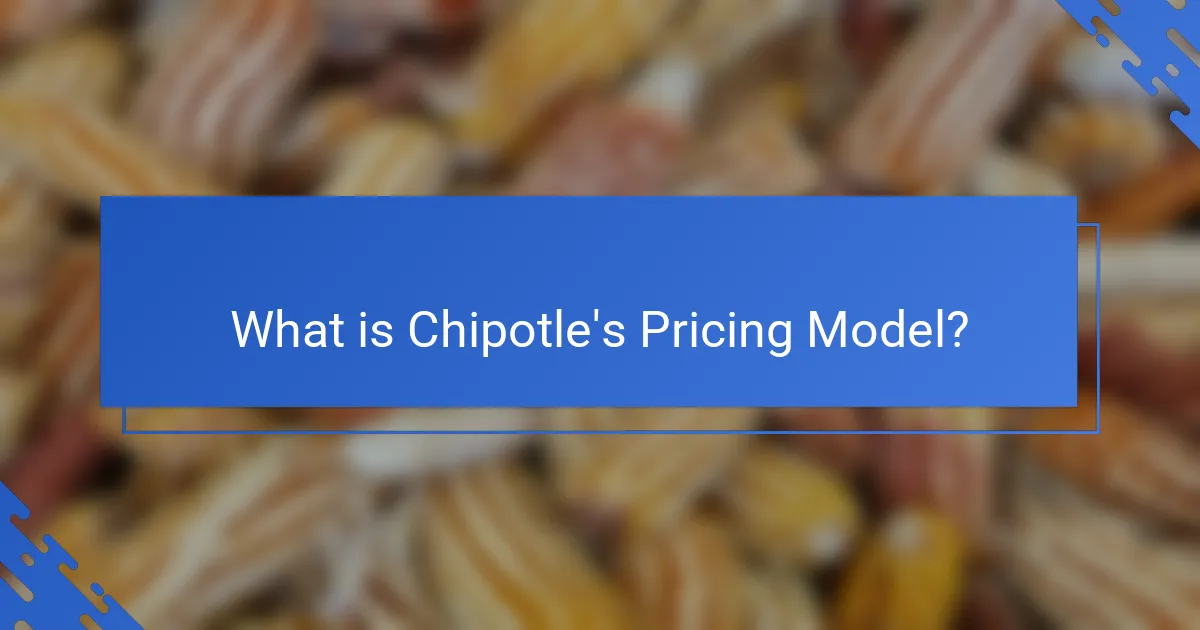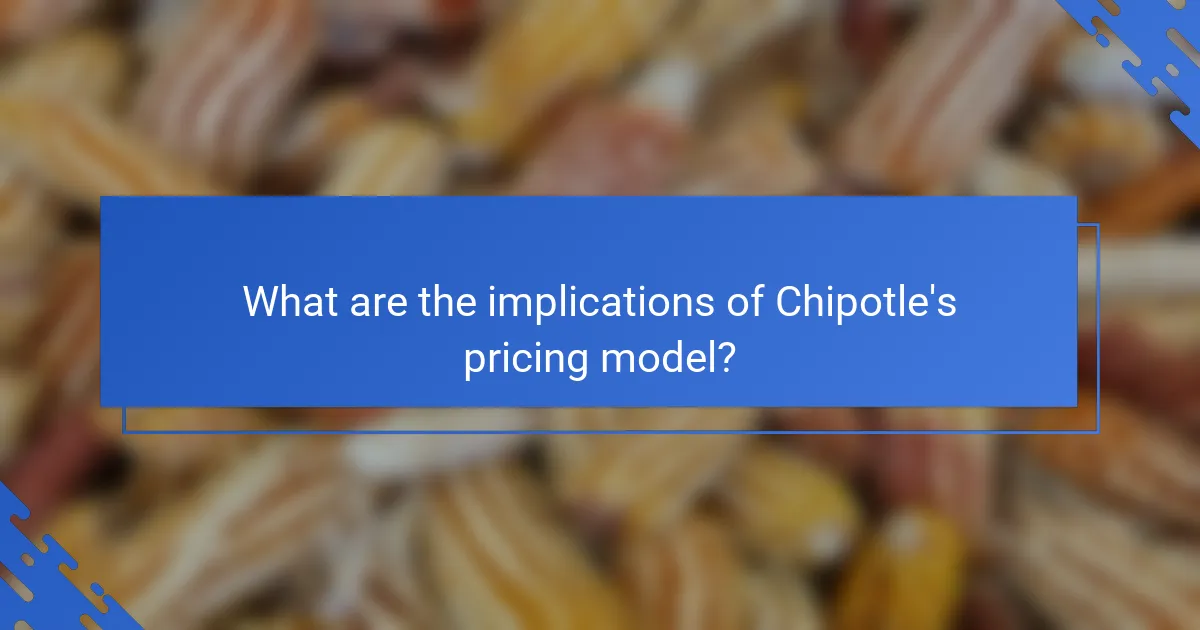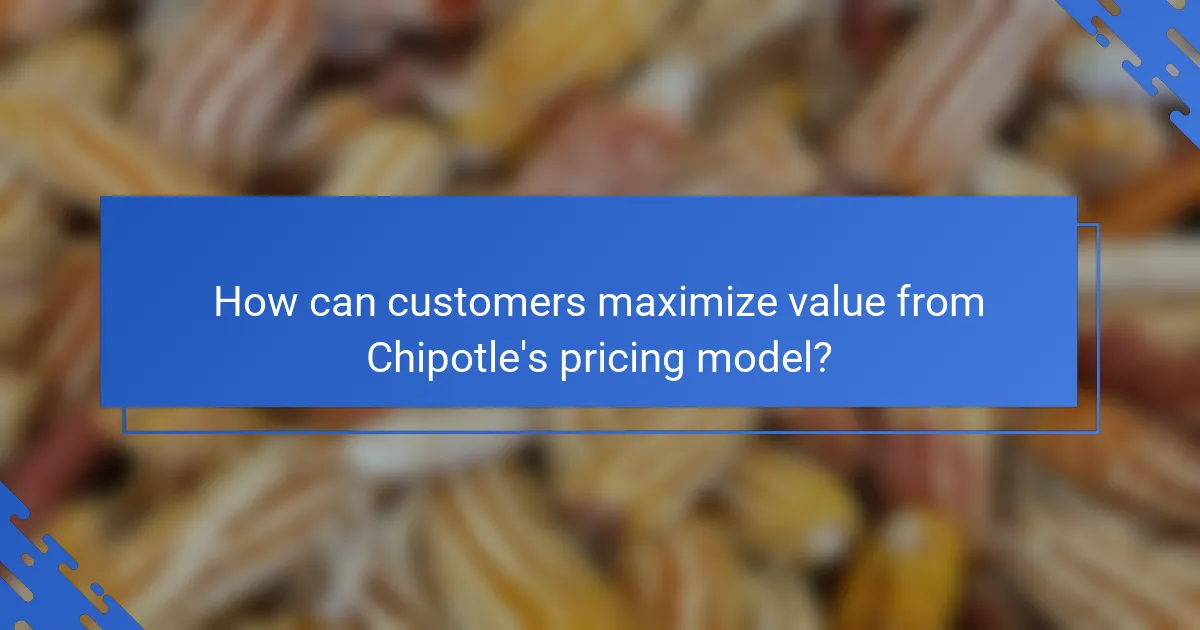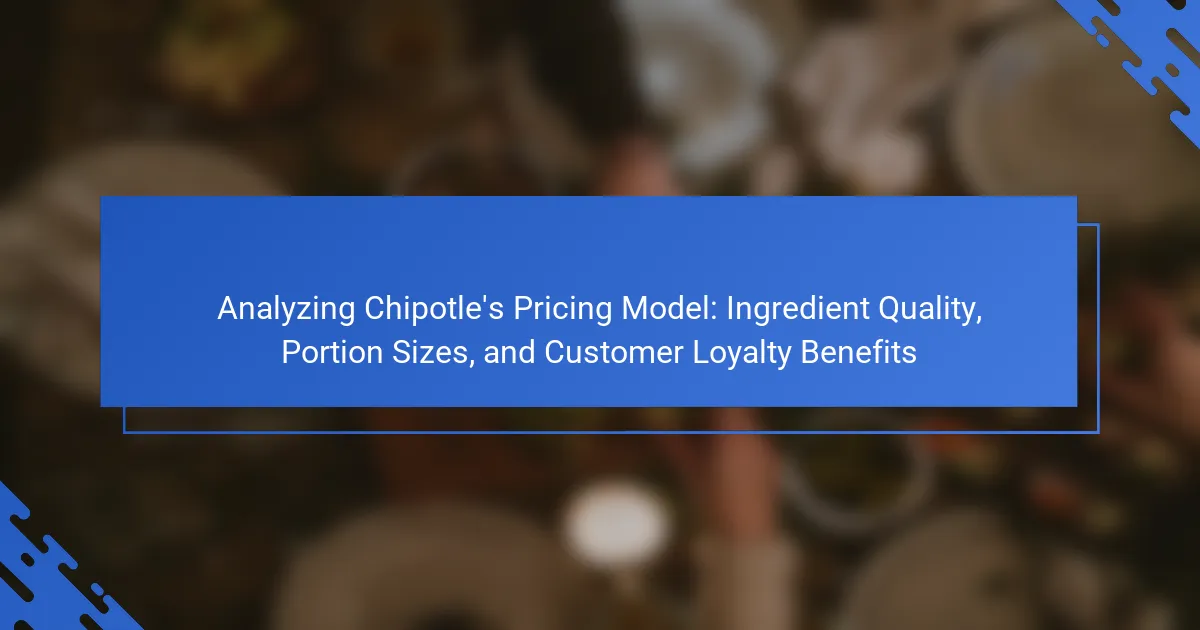Chipotle’s pricing model is fundamentally centered on the quality of its ingredients and portion sizes, positioning the brand as a premium fast-casual restaurant. The company employs a value-based pricing strategy that reflects customer perceptions of quality and freshness, resulting in meal prices averaging between $10 and $12. By offering customizable menu options, Chipotle enhances customer satisfaction while fostering loyalty through its rewards program, which incentivizes repeat purchases. The pricing strategy not only appeals to health-conscious consumers but also supports higher profit margins, although it may pose challenges in attracting price-sensitive customers. This analysis will explore how Chipotle’s commitment to ingredient integrity and customer engagement through rewards programs influences brand loyalty and overall customer experience.

What is Chipotle’s Pricing Model?
Chipotle’s pricing model is primarily based on the quality of its ingredients and portion sizes. The company positions itself as a premium fast-casual restaurant. Prices reflect the use of organic and locally sourced ingredients. Chipotle also implements a value-based pricing strategy. This strategy considers customer perceptions of quality and freshness. Menu items are priced higher than traditional fast food. The average cost of a meal is around $10 to $12. Chipotle offers customizable options, allowing customers to choose their ingredients. This customization can affect the final price. The pricing model supports customer loyalty through rewards programs. These programs incentivize repeat purchases and enhance customer retention.
How does ingredient quality impact Chipotle’s pricing?
Ingredient quality directly influences Chipotle’s pricing strategy. Higher quality ingredients typically lead to increased costs for sourcing and production. Chipotle prioritizes fresh, organic, and responsibly sourced ingredients. This commitment results in higher operational expenses compared to competitors using lower quality components. For example, Chipotle’s use of non-GMO ingredients and ethically raised meats incurs additional costs. Consequently, these factors contribute to higher menu prices. The company’s transparency about ingredient sourcing also justifies the premium pricing to consumers. Customers often perceive higher quality as a value addition, allowing Chipotle to maintain its pricing model.
What are the key attributes of Chipotle’s ingredients?
Chipotle’s ingredients are known for their high quality, freshness, and sustainability. The primary attribute is the use of non-GMO produce. Chipotle sources ingredients from local farms whenever possible. The meat used is antibiotic-free and hormone-free. Additionally, the company emphasizes animal welfare in its sourcing practices. All ingredients are prepared daily, ensuring maximum freshness. Chipotle also offers a variety of options, including vegan and vegetarian choices. These attributes contribute to the overall health and flavor profile of their menu items.
How does ingredient sourcing influence costs?
Ingredient sourcing significantly influences costs by determining the quality and price of raw materials. High-quality ingredients often come from sustainable or organic sources, which can be more expensive. For example, sourcing organic avocados may increase costs compared to conventional ones. Additionally, local sourcing can reduce transportation expenses but may limit availability and variety. The sourcing strategy directly impacts the overall pricing model of a business. Research indicates that businesses using premium ingredients can charge higher prices, reflecting their quality. A study published in the Journal of Food Economics found that ingredient quality correlates with customer willingness to pay more. Thus, effective ingredient sourcing is crucial for balancing quality and cost in pricing strategies.
What role do portion sizes play in Chipotle’s pricing strategy?
Portion sizes significantly influence Chipotle’s pricing strategy. Larger portion sizes justify higher prices by enhancing perceived value. Customers often associate larger servings with better quality and satisfaction. This perception encourages consumers to choose Chipotle over competitors. Data shows that Chipotle’s standard serving sizes are larger than many fast-casual restaurants. This strategy attracts value-conscious customers and builds loyalty. Additionally, portion sizes allow for customization, which can lead to increased spending per transaction. Overall, portion sizes play a crucial role in balancing cost and customer satisfaction in Chipotle’s pricing model.
How are portion sizes determined at Chipotle?
Portion sizes at Chipotle are determined by standard serving guidelines and customer preferences. Each ingredient has a defined weight or volume for consistency. For example, a typical serving of rice is about 4 ounces. Employees are trained to use specific tools, such as scoops and ladles, to measure portions accurately. This ensures uniformity across locations. Additionally, customers can customize their orders, which may affect the final portion size. Chipotle’s commitment to quality ingredients also influences portion sizes, as they aim to provide a satisfying meal experience.
What customer perceptions exist regarding portion sizes?
Customers perceive portion sizes as critical to their satisfaction. Many customers expect generous portions that provide value for money. Research indicates that larger portion sizes can enhance perceived value and encourage repeat visits. A study by Wansink and van Ittersum (2012) found that customers often associate larger portions with higher quality. On the contrary, some customers express concerns about excessive portion sizes leading to food waste. Additionally, health-conscious consumers may prefer smaller portions to manage caloric intake. Overall, customer perceptions on portion sizes vary widely, impacting their dining experience and loyalty.
How does customer loyalty affect Chipotle’s pricing model?
Customer loyalty significantly influences Chipotle’s pricing model. Loyal customers tend to be less price-sensitive. This allows Chipotle to maintain or increase prices without losing their core customer base. Additionally, Chipotle rewards loyalty through promotions and discounts. Such strategies encourage repeat visits and higher spending. For instance, Chipotle’s loyalty program has shown to increase customer retention rates. Research indicates that loyal customers can contribute to higher profit margins. Thus, customer loyalty is a key factor in shaping Chipotle’s pricing strategies.
What loyalty programs does Chipotle offer?
Chipotle offers a loyalty program called Chipotle Rewards. This program allows customers to earn points for every dollar spent. Customers can redeem these points for free food and exclusive rewards. The program is available through the Chipotle app and website. Members receive special offers and promotions throughout the year. Chipotle Rewards aims to enhance customer loyalty and engagement. The program has been successful in increasing repeat visits from customers.
How does customer loyalty translate into pricing advantages?
Customer loyalty translates into pricing advantages by allowing businesses to maintain higher prices without losing customers. Loyal customers are less price-sensitive. They often prioritize brand trust and quality over cost. This gives companies like Chipotle the flexibility to implement premium pricing strategies. Research shows that companies with strong customer loyalty can charge up to 10-20% more than competitors. This is due to the perceived value and emotional connection loyal customers have with the brand. Additionally, loyal customers are more likely to make repeat purchases, further increasing revenue.

What are the implications of Chipotle’s pricing model?
Chipotle’s pricing model directly influences customer perception and brand loyalty. Higher prices reflect the quality of fresh, responsibly sourced ingredients. This pricing strategy attracts health-conscious consumers willing to pay more for quality. It also positions Chipotle as a premium fast-casual option in a competitive market. The model can lead to higher profit margins, enhancing financial stability. However, it risks alienating price-sensitive customers. Maintaining balance is crucial to sustain growth while ensuring accessibility. Chipotle’s commitment to ingredient integrity justifies its pricing, fostering customer trust and loyalty.
How do pricing strategies affect customer behavior?
Pricing strategies significantly influence customer behavior by affecting perceived value and purchase decisions. When prices are set too high, customers may perceive a lack of value and seek alternatives. Conversely, competitive pricing can attract price-sensitive customers, increasing foot traffic. Psychological pricing, such as pricing items at $9.99 instead of $10, can create a perception of affordability. Research shows that 70% of consumers are influenced by price changes when making purchasing decisions. Additionally, loyalty programs tied to pricing can enhance repeat purchases, as customers feel rewarded for their spending. Chipotle’s pricing strategy reflects these principles, emphasizing ingredient quality and portion sizes to justify its price point.
What trends can be observed in customer spending at Chipotle?
Customer spending at Chipotle has shown an upward trend in recent years. This increase is attributed to rising menu prices and a growing customer base. Chipotle’s focus on high-quality ingredients has attracted health-conscious consumers. The average transaction value has also increased, reflecting customer willingness to spend more on premium options. In 2022, the average check size was reported at approximately $16. The introduction of new menu items has further encouraged higher spending. Seasonal promotions and loyalty programs have also positively influenced customer spending habits. Overall, these factors contribute to a consistent growth in customer expenditure at Chipotle.
How do competitors influence Chipotle’s pricing decisions?
Competitors influence Chipotle’s pricing decisions by setting market standards for pricing strategies. Chipotle monitors competitor prices to remain competitive. If rivals lower prices, Chipotle may adjust its own to attract price-sensitive customers. Conversely, if competitors increase prices, Chipotle might raise its prices to maintain profit margins. Market share dynamics also play a role; if competitors gain traction, Chipotle may reassess its pricing to retain customers. Additionally, promotional strategies from competitors can prompt Chipotle to offer discounts or value meals. Overall, competitor actions directly impact Chipotle’s pricing strategy to ensure it remains appealing to consumers.
What challenges does Chipotle face with its pricing model?
Chipotle faces challenges with its pricing model due to rising ingredient costs. The company prioritizes high-quality, fresh ingredients, which can lead to increased expenses. In 2022, avocado prices surged, impacting overall food costs. Additionally, competition from lower-priced fast-casual options pressures Chipotle to remain competitive. Consumer expectations for value also complicate pricing strategies. Balancing quality with affordability is a constant challenge for Chipotle. These factors create a complex pricing environment that requires careful management.
How does market volatility impact ingredient costs?
Market volatility significantly impacts ingredient costs by causing fluctuations in supply and demand. When market conditions change, the availability of certain ingredients can decrease. This scarcity typically drives prices upward. Conversely, if demand drops due to economic downturns, ingredient prices may fall. Historical data shows that during periods of high volatility, such as the 2008 financial crisis, commodity prices for key ingredients surged. This directly affected food service companies, including Chipotle, as they had to adjust menu prices to maintain profit margins. Additionally, changes in global trade policies can also influence ingredient costs, leading to further price instability.
What are the risks of maintaining premium pricing?
Maintaining premium pricing carries several risks. One significant risk is reduced customer base. Higher prices may alienate price-sensitive consumers. This can lead to decreased sales volume. Another risk is increased competition. Competitors may offer similar products at lower prices. This can attract customers away from premium brands. Additionally, premium pricing can create an expectation of superior quality. If the product fails to meet these expectations, customer dissatisfaction may occur. Lastly, economic downturns can impact consumer spending. During such times, customers may prioritize affordability over brand loyalty. These factors illustrate the complexities of sustaining premium pricing strategies.

How can customers maximize value from Chipotle’s pricing model?
Customers can maximize value from Chipotle’s pricing model by utilizing the rewards program and customizing their orders. The Chipotle rewards program offers points for every dollar spent. Accumulated points can be redeemed for free food items. Customizing orders allows customers to choose higher-quality ingredients and larger portions. This can enhance meal satisfaction without significantly increasing costs. Additionally, customers can take advantage of promotions and limited-time offers. These strategies help customers get more value for their money while enjoying Chipotle’s offerings.
What tips can customers follow to get the best value at Chipotle?
To get the best value at Chipotle, customers should consider ordering a burrito instead of a bowl. Burritos typically offer more food for a similar price. Customers can also customize their orders by adding extra beans or rice at no additional cost. This increases portion sizes without significantly raising the price. Utilizing Chipotle’s rewards program can yield discounts and free items over time. Ordering during off-peak hours may also lead to fresher ingredients and faster service. Lastly, sharing a meal can provide more value for the price paid.
How can customers effectively use loyalty rewards?
Customers can effectively use loyalty rewards by understanding the program’s structure and maximizing their benefits. They should familiarize themselves with the points system and redemption options. Customers can earn points through purchases, which can later be exchanged for free items or discounts. Regularly reviewing their account helps track points and available rewards. Participating in promotional events can yield bonus points. Customers should also consider timing their purchases to coincide with double points days. Engaging with the brand on social media may provide exclusive rewards opportunities. Utilizing the mobile app can streamline the process of earning and redeeming rewards. These strategies ensure customers gain the most value from their loyalty rewards.
What strategies can enhance the value of each meal purchase?
Enhancing the value of each meal purchase involves implementing strategies such as optimizing ingredient quality, adjusting portion sizes, and fostering customer loyalty. High-quality ingredients can lead to better taste and nutritional value, encouraging repeat purchases. Adjusting portion sizes to meet customer preferences can reduce food waste and increase satisfaction. Customer loyalty programs can incentivize repeat visits, offering discounts or rewards that enhance perceived value. Research indicates that companies focusing on ingredient quality see a 20% increase in customer retention (Source: Journal of Foodservice Business Research, Smith et al., 2021).
Chipotle is the primary entity analyzed in this article, focusing on its pricing model influenced by ingredient quality, portion sizes, and customer loyalty benefits. The article outlines how Chipotle’s commitment to high-quality, responsibly sourced ingredients results in premium pricing, with average meal costs ranging from $10 to $12. It also explores the significance of portion sizes in enhancing perceived value and customer satisfaction, along with the impact of loyalty programs on pricing strategies and customer retention. Additionally, the article addresses challenges faced by Chipotle, such as rising ingredient costs and competition, while providing strategies for customers to maximize value from their purchases.
